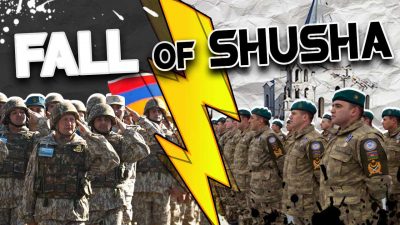Video: Armenian Defense Collapsed in Central Nagorno-Karabakh. Shusha Is in the Hands of Azerbaijan

The Armenian defense in the central part of the Nagorno-Karabakh region is in a deep crisis.
Intense clashes in the areas of Martuni and Shusha were ongoing for the entire last week. Nonetheless, on the evening of November 7, Azerbaijani units were able to achieve notable progress in the battle for this key Armenian stronghold by reaching its northeastern countryside and disrupting the road link between Shusha and Stepanakert. Some Azerbaijani units even entered the town itself.
On the morning of November 8, clashes there continued and, in the afternoon, Azerbaijani President Ilham Aliyev announced that Azerbaijani forces had captured the town. Pro-Azerbaijani sources immediately declared that at least 800 Armenian soldiers were killed during the clashes there. These developments came amid the evacuation of civilians from the capital of the Armenian Nagorno-Karabakh Republic, Stepanakert, which is located just north of Shusha. Nonetheless, local authorities were able to contain the panic. On top of this, the Armenian military declared that the Azerbaijani statement about the capturing of Shusha is untrue and that clashes were still ongoing in the town and its surroundings. According to Armenian sources, a large number of Azerbaijani troops were already killed there.
As of the morning of November 9, the Azerbaijani military has not been able to fully secure Shusha. This allows the Armenian side to declare that the claims of Aliyev and the Azerbaijani Defense Ministry are false. The fact that clashes erupted inside Shusha itself already demonstrate the scale of the troubles faced by the Armenians.
On the afternoon of November 9, the Azerbaijani military released a video confirming its control over the town of Shusha. Therefore, the Armenian resistance is now likely concentrated in its northern countryside. The town is outflanked from at least three sides: from the south, west and east. The only road outside Shusha not under control of the Turkish-Azerbaijani bloc leads to the north, towards Stepanakert. It is under a de-facto fire control of the advancing forces and clashes are ongoing near it.
If Ankara and Baku cut off the road towards Stepanakert, the Armenian forces remaining there will have almost no chance to challenge Azerbaijani control over the town. They will have two main options: The first is to die trying to buy time for the evacuation of civilians from Stepanakert and a possible counter-attack from the north. The second is to retreat from the town via the mountains and try to conduct sabotage and reconnaissance raids against the Turkish-Azerbaijani forces from the gray zone.
The inability of the Armenian side to defend its key stronghold in the center of Nagorno-Karabakh demonstrates that they don’t have not enough means and measures to regain the initiative in the ongoing war and their current main hopes are now concentrated on the nearing winter that should complicate the military activities in the mountains and the intervention of some third party.
The current Armenian leadership has been actively working in an attempt to gain support of the United States and the European Union to pressure Azerbaijan and Turkey to agree on some kind of ceasefire that would allow the Armenian forces to avoid a total defeat. Nonetheless, so far, these efforts have led to no results as the Western world is more concerned regarding the negative tendencies in the US amid the controversial elections that led to the alleged victory of Joe Biden. As to Russia, with which Yerevan had been destroying relations over the previous years, it is not likely to directly intervene in the war on the side of Armenia if there is no direct threat to sovereign Armenian borders or the undeniable evidence of ethnic cleansing of Armenians on the territories captured by the Azerbaijani-Turkish bloc.
Another factor is Iran. Tehran has already concentrated a large group of forces on the border with Karabakh. This group is much larger than that needed to contain some incidents that may appear on the border in the current conditions. Iran as well as Russia are not interested in the further destabilization of the region. Therefore, while the current government in Yerevan cannot be described as being allied to them, they will likely contribute additional diplomatic efforts and pressure to the sides to de-escalate the conflict. The Turks and Azerbaijanis fully understand this situation and thus their current goal is to make as many military achievements as possible in order to set conditions for securing of these gains on the diplomatic scene.
*
Note to readers: please click the share buttons above or below. Forward this article to your email lists. Crosspost on your blog site, internet forums. etc.
SUPPORT SOUTHFRONT:
PayPal: [email protected], http://southfront.org/donate/ or via: https://www.patreon.com/southfront

